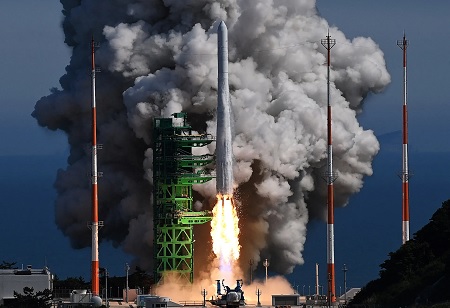
KASA Announces South Korea's Reusable Rocket Tech Strategy

 The newly established National Space Agency of South Korea is reportedly collaborating with private companies to develop small reusable rockets and to investigate one of the stable Lagrange points, aiming to position itself as one of the top five global space powers. Rho Kyung-won, Deputy Chief of the Korea AeroSpace Administration (KASA), confirmed this in a press briefing, stating that the agency plans to entrust the development of reusable rockets to the private sector.
The newly established National Space Agency of South Korea is reportedly collaborating with private companies to develop small reusable rockets and to investigate one of the stable Lagrange points, aiming to position itself as one of the top five global space powers. Rho Kyung-won, Deputy Chief of the Korea AeroSpace Administration (KASA), confirmed this in a press briefing, stating that the agency plans to entrust the development of reusable rockets to the private sector.
According to the report, these reusable rockets are designed to carry a 500-kilogram payload into a 500-kilometer orbit, in line with current space industry trends. Historically, the South Korean government has spearheaded all space initiatives, concentrating on the development of disposable rockets like the 200-ton Nuri and the upcoming KSLV-Ⅲ.
This new plan reflects KASA's commitment to transforming the country's space sector from a government-led industry to a private-led one. KASA is said to further intend to create a launch complex for private space vehicles within the Naro Space Center in the southern coastal village of Goheung and establish a separate space centre at a yet-to-be-determined location. In addition, KASA plans to unveil a road map to explore deep space beyond the moon and Mars through international cooperation in a bid to expand South Korea's space economy territory.
Two years ago, the country announced its plan to land a homegrown spacecraft on the moon in 2032 and Mars in 2045. It now plans to also send a spaceship to L4, one of the five Lagrange points about 380,000 kilometres from Earth, to observe the sun. Lagrange points are positions in space where the gravitational forces of a two-body system like the sun and Earth create areas of stability. These points allow spacecraft to conduct exploration missions with minimal fuel consumption.
Within the set of five Lagrange points, L4 and L5 are acknowledged for their stability, positioned at the apex of two equilateral triangles with the sun and Earth as their vertices. Additionally, KASA disclosed intentions to prepare a second Korean astronaut, aligning with efforts to establish a lunar base by the 2040s. Furthermore, the agency aims to devise a plan for investigating asteroid 99942 Apophis, slated for its close approach to Earth in 2029.
KASA has outlined its ambitious long-term goals, which involve the development of advanced communications satellites with high-resolution capabilities, alongside the establishment of deep space optical communications and space internet technologies. These initiatives, collectively named the Space Gwanggaeto Project after the renowned King Gwanggaeto the Great of the ancient Goguryeo dynasty (37 BC-AD 668), aim to honor Korea's historical legacy while pursuing cutting-edge advancements. Additionally, the agency seeks to cultivate a space ecosystem driven by the private sector, fostering both domestic growth and international collaboration. This commitment extends to participation in NASA's "Moon to Mars" program, which encompasses the Artemis project.

